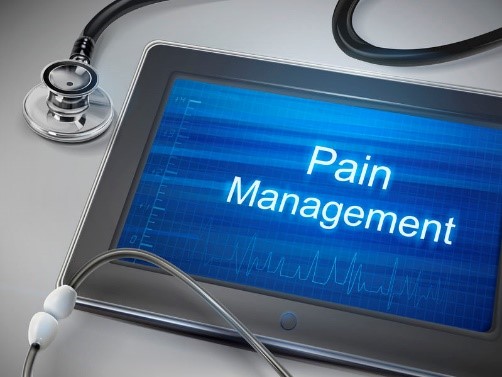How the CDC “Guidelines” are Wrong in Many Ways
The Opioid Crisis has revealed the real problem, the Chronic Pain Crisis
The following are my views and mine alone.
I have followed this situation closely and from the first release of the “Guidelines”, I knew there was deep trouble ahead. The document was poorly assembled and took a dangerous and irresponsible look at people living with chronic pain who I call my sisters and brothers. From the beginning, I knew the “Guidelines” were masking what the real opioid epidemic was, and unfortunately still is illegal opioids and the failed war on drugs.
The worst illegal opioids are heroin and carfentanil (a synthetic opioid 10,000 times stronger than morphine). The public constantly is confusing synthetic fentanyl and carfentanil, with prescription fentanyl. Carfentanil is marketed under the trade name "Wildnil" as a general anesthetic agent for large animals only. Prescription fentanyl is an extremely potent opioid pain medication.
 Legally prescribed opioid pain medications are a necessity for many to have some quality of life. For too many, it is not a high quality of life, but they are thankful to have what they can. Those in society not touched by chronic pain do not understand. “Walk a mile in my shoes…” is a known saying. Yet someone will never be able to understand someone else’s pain until they have their own.
Legally prescribed opioid pain medications are a necessity for many to have some quality of life. For too many, it is not a high quality of life, but they are thankful to have what they can. Those in society not touched by chronic pain do not understand. “Walk a mile in my shoes…” is a known saying. Yet someone will never be able to understand someone else’s pain until they have their own.
The “Guidelines” create a huge problem in the very first sentence of the Rationale section:
”Primary care clinicians report having concerns about opioid pain medication misuse, find managing patients with chronic pain stressful, express concern about patient addiction, and report insufficient training in prescribing opioids (26).”
(Source: CDC Guideline for Prescribing Opioids for Chronic Pain — the United States, 2016)
Reference 26 refers to Beliefs and attitudes about opioid prescribing and chronic pain management: a survey of primary care providers. J Opioid Management 2014;10:375–82 by Jamison RN, Sheehan KA, Scanlan E, Matthews M, Ross EL.
Contained in this reference are some interesting numbers which people should not accept lightly:
RESULTS:
Fifty-six (N = 56) PCPs from eight centers participated in this study. In general, the PCPs showed adequate opioid knowledge on the KOT and their general health was unrelated to prescription attitudes. Most expressed concern about medication misuse (89 percent) and felt that managing patient with chronic pain was stressful (84 percent). Most were worried about addiction (82 percent) and less than half felt that they were sufficiently trained in prescribing opioids (46 percent). Younger providers felt more reluctant to prescribe opioids, experienced more stress in managing patients with pain, had less overall confidence in managing patients with pain, and worried more about opioid dependence than older providers (p < 0.05). Younger providers were also less knowledgeable about opioids, but opioid knowledge was not found to be related to concerns about analgesic prescriptions.
CONCLUSION:
This study indicates a general concern and reluctance of primary care physicians to manage the prescribing of opioids among their patients with chronic pain, and younger providers expressed more concern about opioids than older providers.
(Source: National Center for Biotechnology Information, U.S. National Library of Medicine)
 It appears to be bad news correct? Let’s break down the numbers. What should shock people into questioning the statement is: “Fifty-six (N = 56) PCPs from eight centers participated in this study.” Only 56 PCP’s (primary care clinicians) participated. That’s not a misquote, they didn’t have 560 or 5,600 participating PCP’s, they went with the opinions of just 56.
It appears to be bad news correct? Let’s break down the numbers. What should shock people into questioning the statement is: “Fifty-six (N = 56) PCPs from eight centers participated in this study.” Only 56 PCP’s (primary care clinicians) participated. That’s not a misquote, they didn’t have 560 or 5,600 participating PCP’s, they went with the opinions of just 56.
Being curious I did a search of PCP’s near me, I live in Milwaukee, Wisconsin in the northwest part of the city. Within 5 miles of my home, there are 55 PCP’s., within 10 miles there are 157. Those results were connected to just one of the local medical systems. An open search of all medical systems showed 131 PCP’s within 5 miles and 577 within 10 miles. Yet the CDC based a wide-reaching set of public guidelines based on the input of just 56 PCP’s in the country. Take a moment to let that sink in.
The problem with surveys and polls is that the results can, and many times are, sifted through to provide the results desired. I do not know for a fact that this occurred here. I am not stating that is what happened. I am only offering information and references for others to consider.
With just addressing one sentence of the Rationale for the CDC Guidelines I do believe I have called into question the overall document. The other part of this one sentence which has never felt right to me is the first three words: “Primary care clinicians." The topic is chronic pain and I wondered why they didn’t survey pain management doctors' PMDs.
Taking into consideration the number of PCP’s I found near me when I looked for PMD’s (pain management doctors) the numbers were drastically lower. Within 5 miles there were only 12 (compared to 131 PCP’s), and only 44 within 10 miles compared to 577 PCP’s.
What is a pain management doctor?
 A pain management specialist is a physician with special training in the evaluation, diagnosis, and treatment of all different types of pain. Pain is actually a wide spectrum of disorders including acute pain, chronic pain, and cancer pain, and sometimes a combination of these. Pain can also arise for many different reasons such as surgery, injury, nerve damage, and metabolic problems such as diabetes. Occasionally, pain can even be the problem all by itself, without any obvious cause at all."
A pain management specialist is a physician with special training in the evaluation, diagnosis, and treatment of all different types of pain. Pain is actually a wide spectrum of disorders including acute pain, chronic pain, and cancer pain, and sometimes a combination of these. Pain can also arise for many different reasons such as surgery, injury, nerve damage, and metabolic problems such as diabetes. Occasionally, pain can even be the problem all by itself, without any obvious cause at all."
As the field of medicine learns more about the complexities of pain, it has become more important to have physicians with specialized knowledge and skills to treat these conditions. In-depth knowledge of the physiology of pain, the ability to evaluate patients with complicated pain problems, understanding of specialized tests for diagnosing painful conditions, appropriate prescribing of medications to varying pain problems, and skills to perform procedures (such as nerve blocks, spinal injections, and other interventional techniques) are all part of what a pain management specialist uses to treat pain. In addition, the broad variety of treatments available to treat pain is growing rapidly and with increasing complexity. With an increasing number of new and complex drugs, techniques, and technologies becoming available every year for the treatment of pain, the pain management physician is uniquely trained to use this new knowledge safely and effectively to help his or her patients.
(Source: American Society of Regional Anesthesia and Pain Medicine)
On April 10, 2019, a Health Professionals for Patients in Pain (HP3) press release shared a response they received from an inquiry to the CDC regarding the Guidelines:
 On April 10, the Director for the Centers for Disease Control and Prevention, Dr. Robert Redfield, wrote to Health Professionals for Patients in Pain (HP3) to state that the CDC’s 2016 Guideline offered no support for mandatory opioid dose reductions in patients with long-term pain. Coming on the heels of an April 9 warning from the United States Food and Drug Administration of “serious harm” to patients after rapid dose reduction or discontinuation, the Director’s letter flags the need for a recalibration of care decisions imposed by a wide range of private and governmental agencies that have invoked the CDC to justify coverage restrictions, quality metrics, legal threats and other actions to force dose reductions on nonconsenting patients.
On April 10, the Director for the Centers for Disease Control and Prevention, Dr. Robert Redfield, wrote to Health Professionals for Patients in Pain (HP3) to state that the CDC’s 2016 Guideline offered no support for mandatory opioid dose reductions in patients with long-term pain. Coming on the heels of an April 9 warning from the United States Food and Drug Administration of “serious harm” to patients after rapid dose reduction or discontinuation, the Director’s letter flags the need for a recalibration of care decisions imposed by a wide range of private and governmental agencies that have invoked the CDC to justify coverage restrictions, quality metrics, legal threats and other actions to force dose reductions on nonconsenting patients.
The CDC’s Director’s April 10 response specified that:
- Cautionary dose thresholds from the CDC’s 2016 Guideline had been intended to apply only for “initiation” of opioids, rather than for the care of longstanding recipients who were stable at higher doses.
- Clinicians must “work with patients to taper or reduce dosage only when patient harm outweighs the patient benefit of opioid therapy.”
- For patients already receiving doses higher than 90 morphine milligram equivalents, “the recommendations include reviewing the risks and benefits of continuing high-dosage therapy, and if a patient would like to taper, collaborating with the patient on an individualized plan.”
The Guidelines did not state mandatory opioid tapering or elimination by doctors. The above statements from the CDC are welcome, but too many lives have been lost over the last 3 years that we were targetted by the Guidelines. Who is responsible for all the damage which occurred?
Another view to consider
SCOPE by Stanford Medicine published an article on March 6, 2019: “Can we address both chronic pain and the opioid crisis? Yes, pain doctors say” by Mandy Erickson.
Numbers within the article do not add up in ways to support targeting responsible pain patients who take opioid medications to have some quality of life. The article said:
"20 million Americans suffer from high-impact chronic pain, or pain so severe it impairs their daily lives." Then it says: "every day 130 Americans die from overdosing on opioids. Some of them became addicted after being prescribed opioids after surgeries or other procedures."
National Institutes of Health, of the U.S. Department of Health and Human Services, classifies High Impact Chronic Pain (HICP) as a new concept that describes those with pain lasting three months or longer and accompanied by at least one major activity restriction.
Now let’s do some simple math. 130 x 365 days a year = 47,450 lives lost each year, which is one life too many. If we take that result as a percentage of the 20 million Americans suffering from high-impact chronic pain, as per the article, we arrive at .24%. Meaning .24% of the 20 million pain sufferers lose their lives each year. I agree, these are not wonderful numbers to discuss, and 0% would be best, yet we must talk about these because lives are at stake.
In a report dated Tuesday, August 11, 2015, by NIH – National Institutes of Health titled “NIH analysis shows Americans are in pain. The report examines the prevalence, severity, and duration of pain” It stated:
“A new analysis of data from the 2012 National Health Interview Survey (NHIS) has found that most American adults have experienced some level of pain, from brief to more lasting pain, and from relatively minor to more severe pain. The analysis helps to unravel the complexities of a Nation in pain. It found that an estimated 25.3 million adults (11.2 percent) had pain every day for the preceding 3 months. Nearly 40 million adults (17.6 percent) experience severe levels of pain.”
When we do the math using 40 million American adults living with severe levels of pain (high-impact chronic pain) instead of 20 million, we now drop to .12% of deaths due to opioid overdose being connected to chronic pain patients. The evidence yields smaller and smaller numbers yet people living with pain are the targets of a misinformed public. These numbers are extremely important. The public needs to know the facts and then perhaps they can consider the lives involved.
 Also, consider that the population of America is approximately 326 million people of all ages. The two numbers above, 25.3 million-plus 40 million equals 19.94% of the population. Keep in mind that those are only adults and if children were included how high would that percentage increase? People living with chronic pain are the largest minority group in America. It is the only group made up of every walk of life and yet the most disregarded. We face public stigmas which should not exist.
Also, consider that the population of America is approximately 326 million people of all ages. The two numbers above, 25.3 million-plus 40 million equals 19.94% of the population. Keep in mind that those are only adults and if children were included how high would that percentage increase? People living with chronic pain are the largest minority group in America. It is the only group made up of every walk of life and yet the most disregarded. We face public stigmas which should not exist.
A few other interesting notes regarding those 47,450 deaths: 19,413 were due to synthetic opioids (such as synthetic fentanyl), 15,469 due to heroin. Those two make up 34,882 of the reported deaths or 73%. This does not include deaths due to the illegal use of prescription opioids whether someone steals and uses someone else’s medications, illegally obtains them, or when prescription opioids are combined with illegal substances.
(Source: NIH National Institute on Drug Abuse)
In other words, the numbers do not support the attack which has been felt by people living with chronic pain. The numbers show that prescription opioids responsibly taken by the vast majority of chronic pain patients are NOT the cause of the "opioid crisis".
In America approximately 126,000,000 adults live with some form of daily pain, that's about 1/3 the population. Looking at the number of people living with chronic pain, clearly shows we are in a Chronic Pain Crisis. What is going to be done about that? I’ll leave you with this sobering fact, each person is an accident or illness away from living with chronic pain.
Yours in Hope,
Jory Pradjinski
<<-- Back to Renewed Living Blog Email to a friend
